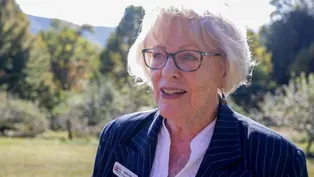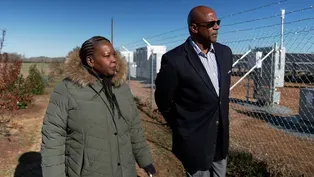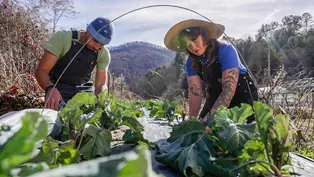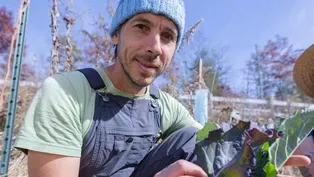
State of Change: Seeds of Hope
Special | 26m 46sVideo has Closed Captions
Meet the North Carolinians who are adapting to climate change in new and inspiring ways.
Meet the North Carolinians who are adapting to our changing climate in new and inspiring ways. From conserving land and growing food that’s tolerant of extreme conditions to using farmland to produce both crops and solar energy, these innovators are facing the challenges of climate change with perseverance and ingenuity.
State of Change is a local public television program presented by PBS NC
State of Change is part of the Pulitzer Center’s Connected Coastlines reporting initiative. For more information, go to https://pulitzercenter.org/connected-coastlines.

State of Change: Seeds of Hope
Special | 26m 46sVideo has Closed Captions
Meet the North Carolinians who are adapting to our changing climate in new and inspiring ways. From conserving land and growing food that’s tolerant of extreme conditions to using farmland to produce both crops and solar energy, these innovators are facing the challenges of climate change with perseverance and ingenuity.
How to Watch State of Change
State of Change is available to stream on pbs.org and the free PBS App, available on iPhone, Apple TV, Android TV, Android smartphones, Amazon Fire TV, Amazon Fire Tablet, Roku, Samsung Smart TV, and Vizio.
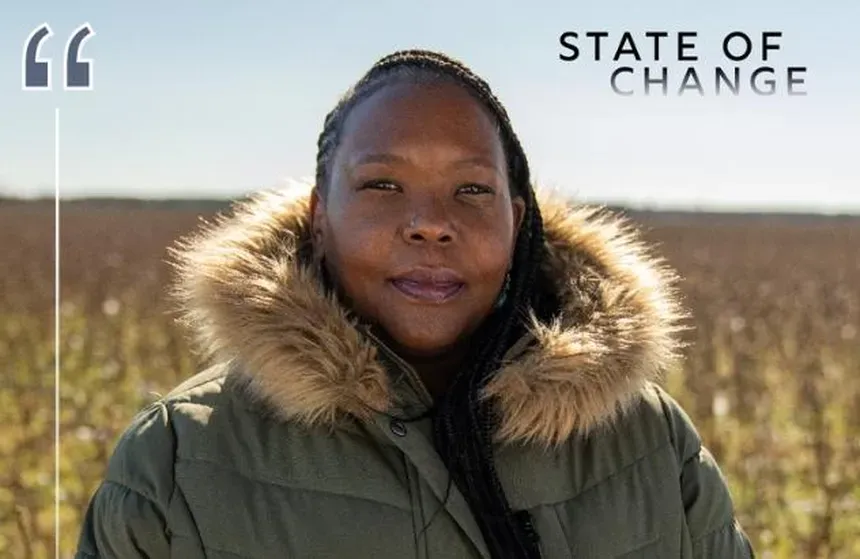
Explore More from State of Change
Hear from North Carolinians about climate change effects & innovative solutions across the state.[piano intro] - [Narrator] Quality public television is made possible through the financial contributions of viewers like you, who invite you to join them in supporting PBS NC.
[gentle music] - [Narrator] North Carolina's climate is changing.
- We're seeing increases in rainfall and precipitation.
We're seeing flooding.
We're seeing increase in heat.
We think about high fire risk.
We think about, how are animals gonna be able to migrate as their climate changes and the temperatures change?
- [Narrator] These changes impact the people, places, ecosystems, and economies of our state.
- We need to, like, do everything we can to fight climate change in terms of mitigation strategies, but it would be foolish to think that we're not going somewhere a little bit more challenging and a little more climate chaotic in the very near future.
How do we adapt to that?
- [Narrator] That's the question.
How do we adapt to a climate with more extremes?
North Carolinians are finding innovative solutions and even thriving despite these challenges.
- And that's really exciting.
[gentle music continues] [gentle music] - [Narrator] Something as simple as protecting the land around us can be a powerful tool to adapt to climate change.
And it's a strategy that can be used across North Carolina.
- Where we're located right now is the Blue Ridge Parkway, which is a unit of the National Park Service.
The views on the parkway are not guaranteed.
There are lots of places along the parkway that are not under conservation permanent protection.
What makes this unit really unique is that it does not take federal government action to expand the park boundary.
All it takes is a cooperative partnership between the park service and a land trust like CTNC.
So what we've been doing for over 20 years now is working with private landowners to acquire land.
Then we hold and steward it until the park service is ready to take it on and add it to the park.
Everything you're looking at right now is protected by a partnership between CTNC and the orchard.
- We bought the orchard in 1995.
My sister, she came from Eastern North Carolina.
She read the want ads, and she saw this orchard advertised for sale.
I asked her what she was gonna do with it, and she said, "Nothing.
I'm gonna make sure this beautiful place is not ruined by a lot of construction and houses and things like that."
[whimsical music] [whimsical music continues] - The motto for this orchard is saving the good stuff, and the good stuff is just what we're looking at.
The views and the trees and the heritage apples, the rich history that exists here, that is what we are trying to protect here.
People want to be out here and pick their own apples and taste them off the tree.
They're getting a whole new taste of an apple.
[apple crunches] Oh, that's good.
- [Mary] Conserved land does not have to be locked up and put away.
Conserved land can absolutely be creating a space that is used.
We're in an agricultural production space right now.
Conserved land can be done with farmers, it can be done with parks and public land and trails, but it can look different for everybody.
- That's the one I want.
- So what you wanna look for on these are these red places we call the red blush.
That's where the sun has kissed the apple, basically.
I'm always telling local people, if you wanna know your story, if you wanna know your history, come to the orchard, because that's where it all is.
The orchard is home to me.
That's the best way I know to say it.
Physically, home is on this mountain straight behind us.
That's where I grew up, and I live very close to where I grew up now.
My great uncle raised his family in the house right out here that is now where my office is.
So, the history there runs thick in my family.
[gentle music] I can tell you that winters are not anywhere near as severe as even when I was growing up 20 years ago.
Not every winter's the same.
Some are worse than others, some are more mild, but it has definitely changed.
More concerning than the winter changing is what we're seeing in the spring.
What sometimes happens is it gets warm a little early in the season, those blossoms come out, and a week later, it gets down to 25, 27 degrees one night, and it sends apple orchardists into panic, because that can kill your apple crop.
Here in the mountains, we get frost up until mid-May, so, a couple weeks early with things blooming out can make a big difference.
Because of where we are in this pocket in the mountains, we have warm air that comes up from the valley below us and rises up over the apple trees.
Nine times out of 10, this bowl here in the mountains and the movement of warm air saves our apple crop from frost and freeze damage.
And that is why the railroad specifically planted it here.
A lot of people say, "Why in the world did they put this orchard on the side of the continental divide?"
But that's why.
- In this part of Western North Carolina, if you look at what the data is telling us, it's telling us this is highly resilient to change, but it's also highly impacted and threatened by the impacts of climate change.
[gentle music] As climate changes, we need to give our plants, animals, and wildlife time to adapt, and the way we can help them adapt is giving them places to go so that they can follow that habitat and resource they need to continue to thrive.
In order to do that, we need contiguous, connected plots of land.
The Blue Ridge Parkway is so unique because we have essentially created over 400 miles, north to south, that has created that connected land, that is gonna give them that extra fighting chance to get where they need to go while the climate's changing.
- It rejuvenates your spirit to know that you're saving something that's so important to nature and our ecosystem.
The air we breathe, the beauty that we see in the mountains behind us, everything is so much bigger than you are as a person.
- I have a family reunion every summer, and when folks come in that are maybe in their 70s and have moved away and haven't lived here since they were a kid, they can't believe all the houses and buildings and structures that have popped up in 60 years.
While that's just part of life, development, at the same time, we need places where we save history and the land, the trees.
It's very important to me.
This orchard is my life.
It's my passion to see that it's saved forever.
[gentle music continues] [gentle music] - [Narrator] On the other side of the state, land is being used for farming and solar energy production.
But how do we install solar in ways that make sure that rural communities get a piece of the renewable energy pie?
- North Carolina's been leading the country for years in our solar generation, which is wonderful.
There are gaps, though, and there are ways to improve.
There's the potential for a broadening of the benefits economically for communities and people who have been historically disadvantaged as a part of this energy transition.
EnerWealth, in many ways, the name kind of embodies what our mission is all about.
We started because I realized, after spending about two decades in rural development, that solar energy investments were going to be the new source of revenue coming into rural communities, and I wanted to be sure that that investment would do more than what it had been doing.
[gentle music] I work with smaller acreage landowners on what's called distributed sized solar generation projects.
So, these are smaller sites.
They're less than five megawatts, typically less than 30 acres.
And in this case, they're actually less than five acres.
And the reason why we build these smaller systems is, one, we're able to capture more value from the solar energy by pairing it with battery storage, and two, because we're trying to demonstrate a way of building solar projects that is co-located alongside agricultural production that's in harmony with the surrounding community and the neighborhood, as a model for the way that solar can be deployed across the rural south, across the country.
Part of the EnerWealth story is helping rural families, especially families with smaller acreage, minority landowners, small farmers, to hold onto their land from one generation to the next.
This beautiful woman here.
- That's Marion Mitchell, that's me.
- That's you.
With your two children.
- [Marion] My two children are Derek and Lavonda.
- And these pictures are a little older.
- Yes, they are, uh-huh.
- So I wanna be very careful with 'em.
- Uh-huh, yeah.
This is my mother.
- Okay.
- Mary Fannie Boone.
This is our father, Bryan J. Boone, right there.
- [Ajulo] Okay.
Oh, and I see right there it says B.J.B on the trailer.
- Uh-huh, yeah.
My grandfather was the one that got it started, because he had bought the land, and like I say, my grandfather had lose the land.
But when he died, he had four children, three boys and one girl, and he made sure each one of 'em had a farm that they owned.
And so that's how this farm got here that my daddy take over.
This was his farm, and he farmed until he was disabled to the farm again.
Then he start leasing it out.
And that's how we've been going ever since.
- We know that land is a source of wealth for people.
The question is, how are they able to maintain it from one generation to the next?
The two landowners that we worked with with our pilot projects are actually African American landowners, and the history of land retention in the African American community is actually a sad story.
Many African American landowners have lost their land, millions and millions of acres over generations, which is amounting to billions of dollars worth of wealth that's been stripped away in one way or the other from those landowners.
The beauty of our projects is that landowners are able to continue to cultivate their land.
It works well for farmers, because this is another way to diversify their revenue streams, to diversify their income.
We do want folks to have the flexibility alongside the solar production to be able to farm or use that land for recreational purposes or any other purpose that the family might want to use it for.
And both can be done.
We are proving this model to show that it's accessible for rural electric cooperatives to have both solar and storage, and that it serves the grid as well as their consumers.
There are 900 rural electric cooperatives across the country.
Many of them are in the southeast.
- Typically, areas that are served by electric cooperatives are gonna be very rural, very agrarian, which is the case here in Northeastern North Carolina, a lot of farmland and a lot of scattered areas, particularly when it comes to the investments that have been made to provide the service.
Projects like this one really bring a lot of layers of benefit to our member owners.
So this is a solar plus battery storage installation.
It's not a microgrid that's serving a home per se.
And it's powering the grid itself when the solar arrays are producing.
And the benefit of the batteries actually brings some flexibility for us as electric cooperatives, because we are buying power, we do not own any generation as electric cooperatives.
And so our needs during specific times of the month call for us to be able to limit our use of the electrical grid, and that's where the batteries come into play.
We're able to reduce costs by making sure that we're relieving ourselves of some more expensive costs during peak periods on the wholesale power grid.
But another layer to this is the work that we're able to do with some of our landowners who are participating in another program that we have here at Roanoke that's called the Sustainable Forestry and Land Retention Program.
These individuals now have an opportunity to bring levels of wealth creation to their families, somewhere in the range of about 30 years, 30 to 40 years, which can traverse several generations.
So we're talking about wealth creation.
We're also talking about job opportunities, community and economic development, tied back to how we make maximum use of the electrical grid.
It is very important for us to make sure that everyone is able to participate.
- [Ajulo] So, about how old do you think this house is?
- [Marion] I know it's about 100 years old.
- [Ajulo] Yeah, at least 100 years old.
- Uh-huh, yeah, it is 100 years old.
See my little garden [indistinct]?
- I see 'em.
- There's one type of salad.
There's another type of salad.
And there's another type of salad over there.
And this is collards.
These are collards.
[gentle music] My mother and father, they worked very hard to keep this land and get the land started.
We're not gonna be selling this land because it stay in the generation, because my mother and father start this farm.
Take care of what you already have.
- They don't make new land.
- Mm-mm, no, they shut it down.
Mm-mm.
- One of the most interesting features of our energy transition is that there's actually a systemic change happening around ownership of energy production.
We've already seen that we believe in this technology by being second in the nation.
Our utility has been benefiting from it for more than a decade now.
And so it's time for everyday people to also be able to benefit from the technology too.
[gentle music continues] [gentle music] - [Narrator] It's not just how we use our farmland that matters.
What we grow on it can also have an impact.
Weather extremes are making farming unpredictable and challenging, especially in the south.
But warmer temperatures also bring new opportunities, like the ability to grow tropical plants in the Carolinas.
The Utopian Seed Project is testing crops that can tolerate this new climate reality.
- Everything comes back down to this concept of exploring diversity in the food and farming system.
[gentle music] The Utopian Seed Project is a non-profit, and we are about four years old.
We don't have a lot of space.
We grow a lot of different things at small scale to kind of showcase them, and then our hope is that we get them to farmers and farmers grow them at a big enough scale to feed the food system.
So, this is year three of selecting for collards that can survive extreme temperatures in the winter.
We started off with 21 heirloom varieties from a project called the Heirloom Collard Project.
And then that winter, we noticed that some of them died when we had this real severe cold weather event, and some of them survived, and so we decided that that's a good thing, if collards can survive unprotected with extreme weather.
Certainly with climate change on the way.
Well, "On the way."
Here.
- The thing that, like, catches people's eye at first is, like, the beautiful purple leaves.
There's also, like, the leaf texture and the leaf shape.
I'm kind of partial to the ones that are kinda super curly like this.
- That naturally existed in the collard populations, that natural diversity where the plants were different, and we're trying to encourage a bit more of that diversity coming in basically by taking two different varieties and letting them share pollen with each other.
It's kind of like having a baby, right?
You know, two different people have a baby, then the baby's gonna look different to the parents.
It might share some traits, but the baby's gonna be a little bit different.
And so we're trying to do that with plants.
Like, how do we get different plant babies so that we have more resilience within that food and farming system?
Basically, what we end up doing is growing a whole bunch of different varieties of crops that people recognize, but we also look at trying to increase the number of crops in the system.
So, like, what crops could be grown here that aren't currently grown at any scale?
These big mother tubers are beautiful once you get down past the slime.
So what we've got in this box is taro.
You can kind of see we pulled up the whole plant.
It's a really ancient food across the tropics, domesticated thousands and thousands of years ago.
It's a staple in lots of different cultures, and the primary crop for us are these root crops here.
Anything you can do with a potato, you can do with taro.
So you can chip it, you can mash it, you can definitely fry it.
It's kinda like a starchy, white fleshed tuba, basically.
A lot of the tropicals, they're like, the instant response is like, "I just didn't know you could grow that here."
And for the large part, I think it's 'cause people have never asked the question.
So, the Utopian Seed Project, sometimes it's just like open-minded curiosity.
"Oh, that sounds cool, can we grow it here?"
And sometimes it's an epic fail, sometimes it's, like, marginal and we keep working with it and we need to find the right variety, and some crops, like taro, we're like, "Oh, wow, that grows really productively here," and really could have a place in the food system.
We've got lots of farmer's markets and farmers, and that's fantastic, but then if we take one more step back from that, we're like, where do those farmers get the seeds to grow that food?
Very, very little seed is grown at any scale in the southeast.
- People that are already, like, interested in local agriculture, it means a lot to them to go to their farmer's market and meet their farmer, and it's, like, part of the system that's very close to home, and I don't think that they understand that those seeds are coming from quite far away.
No matter how many local farmers you have, if you don't have local seed farmers, then, like, there's this, like, weak foundation of the local food system.
- We're all engaged in food because we have to eat.
So whether we recognize it or not, we're part of a food system.
The two basic components of that food system is the supply, the farmers, and the demand, the consumers, but there's lots of other components.
We need to also have a supply chain for the seeds, not just the food, because the farmer can grow the food, but they need the seeds to be able to grow the food.
So, how do we get more seeds into that system?
All these questions that I think are asked of the food system aren't asked of the seed system, but they are as important, if not more important, because that seed is like, it's the genetic, cultural, tiny, little miraculous package of information that informs everything that's gonna happen on the farm from that point forward.
- For farmers, if they're buying seed that is always coming from somewhere very far away, then those plants kind of, like, show up here in the south, and it's like a very different climate.
I've been talking to more local seed savers and people that have kind of committed to saving their own seed on farm, and a lot of them will, like, tell you that they see their yields go up a lot when they start saving their own seed.
I think year after year, when the plant, like, knows where it's from, like, it gives it, like, the chance to adapt to this place.
- As we set up the Utopian Seed Project, we quickly ran into this challenge where we didn't have the space or capacity to grow enough seed to support a regional farmer network.
- And that's kind of how the seed growers collective came about, for there to be more seed growers in this area.
There's a couple barriers that they come up against.
Equipment is a really big one.
There's a big difference between doing everything by hand and having, like, a few simple machines can help you scale up a lot.
It's also expertise.
Mostly, farmers learn from other farmers.
"How did you process this?
How long did you need to let it dry?"
A lot of the seed saving information that's out there is not necessarily, like, tailored super well for our region.
Sometimes we're like, "Oh, it gets really humid here, like, really late in the season.
Do you think I can pull my, like, beans, like, way earlier than somebody else might?"
Just kind of having that conversation with other farmers around you, like, gives you the confidence to be able to do that.
Kind of puts the seed back in the farmer's hands a little bit.
- There's just, like, so much potential and beauty and diversity and flavor in the food system.
Well, not in the food system.
That should be in the food system, and isn't.
How do we get it out there?
How do we make farmers grow it and have chefs and consumers want it?
And some of it's literally just an awareness campaign.
And the challenge with agriculture is it kind of moves slowly, and we have to shift everything at the same time, right?
We could easily persuade a farmer to grow taro, but if they don't have somebody to buy it, then they're not gonna grow it again because they'll be annoyed at me.
[upbeat music] And we could easily persuade a chef and have that taro is delicious and they should have it on their menu, but then their very first question is, "Where can I buy 50 pounds of this every week to put on my menu?"
And we're like, "Oh, okay, we've gotta go back to the farmers."
So, we're always doing this kind of juggling act.
- It's important for farmers to be able to reach the chefs directly.
It's good for our economy and it's good for our community.
I think what he's doing is challenging us, which is great.
Reintroducing or bringing new crops to us.
We're gonna make it enticing to the public because we're gonna cook it, but he's already done the work to grow it, to bring it to us.
What's this variety?
- We have Puerto Rican- - Okay.
- Variety.
It grows bigger mothers.
- I'm gonna actually peel 'em and then slice it and then deep fry 'em and see what happens.
See what happens, right?
My name is J Chong.
Pronouns are she/her.
I live here in Asheville, North Carolina.
I'm a private chef here.
My cuisine is Cantonese food, so it's very important for me to try to bring Cantonese cuisine, try to reintroduce it to Western North Carolina.
I made a sorghum congee, minced pork with some fresh taro in there, and today I'm gonna go ahead and slice some taro thin, deep fry it so we can have some nice chips on top.
Start with some chili oil here.
Some popped sorghum.
- We're doing work in the fields, and I think that's really important, but when these crops and ingredients go through the hands of, like, a professional chef, then they just come out on the other end as like just magical creations.
- This is a yacon.
It's a root vegetable.
It tastes a lot like a potato, but with apple, citrus, like, fruit notes.
It's best baked like a dessert or made into a syrup or a powder, roasted.
Anything you can do with a sweet potato or an apple, really.
- [J] So good, y'all.
Oh my gosh!
- That grows in the ground.
- It does!
- It grows in the ground.
And the ice cream's made from things you grew in the ground too.
- That's true.
This is a root dessert.
It's awesome.
If we're gonna inspire people to change the way they interact with the food and farming system, then this is where it's at.
I can talk about climate resilience and farming techniques all day long, but all you need to do is taste this and go, like, "I wanna have sorghum and yacon in my diet every single day."
[upbeat music] For us, what we think about is maybe in five years time, maybe in 10 years time, we could imagine a food system where some of these crops, like taro or yacon, are being grown by farmers, sold in farmer's markets, maybe they've made them into the co-ops, chefs are buying them, you see them on menus, people are sharing recipes on social media, and nobody even talks about the Utopian Seed Project.
Like, once these crops are, like, autonomously adopted into the food system and just have a life of their own, then we can be like, we've done it.
Job good, let's move on to the next crop, type of thing.
- We need to have agricultural production, and we need to have that alongside clean energy, renewable energy production.
And the two can actually work together.
- What we can do right now is plan for the future and really save these special places so that we have something addressing the impacts that climate change is bringing forward to the state and the people in it.
[upbeat music continues] [upbeat music continues]
Altapass Orchard: Conserving Land for Climate Resiliency
Video has Closed Captions
Land conservation is not a “one size fits all” solution. This orchard shows us one way. (7m 52s)
EnerWealth: Growing Solar Options in Rural Communities
Video has Closed Captions
EnerWealth works with rural farmers in NC to ensure they get a piece of the solar pie. (8m 12s)
Preview | State of Change: Seeds of Hope
Video has Closed Captions
Meet the North Carolinians who are adapting to climate change in new and inspiring ways. (30s)
Utopian Seed Project: Rethinking Our Food System
Video has Closed Captions
The Utopian Seed Project works to build NC’s climate resiliency through crop diversity. (10m 17s)
Providing Support for PBS.org
Learn Moreabout PBS online sponsorshipState of Change is a local public television program presented by PBS NC
State of Change is part of the Pulitzer Center’s Connected Coastlines reporting initiative. For more information, go to https://pulitzercenter.org/connected-coastlines.
